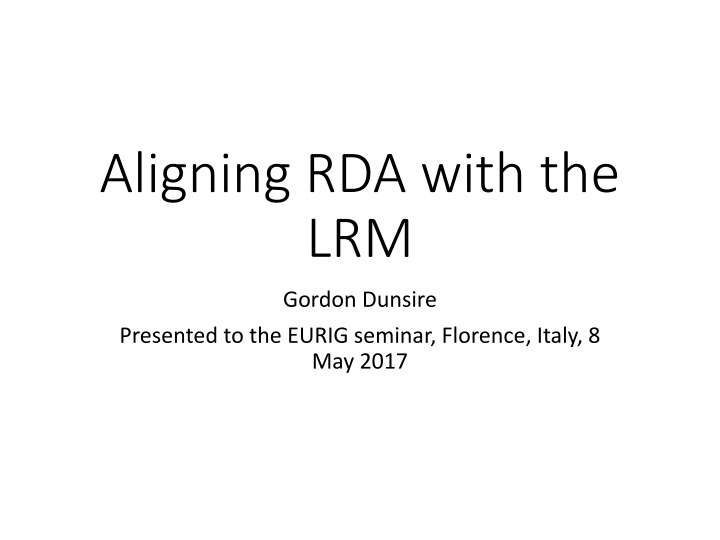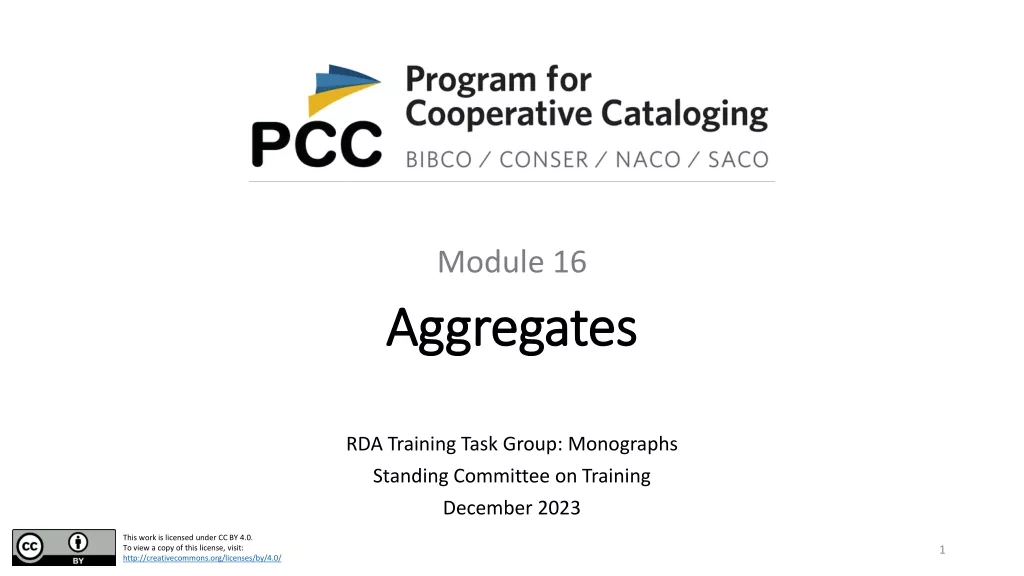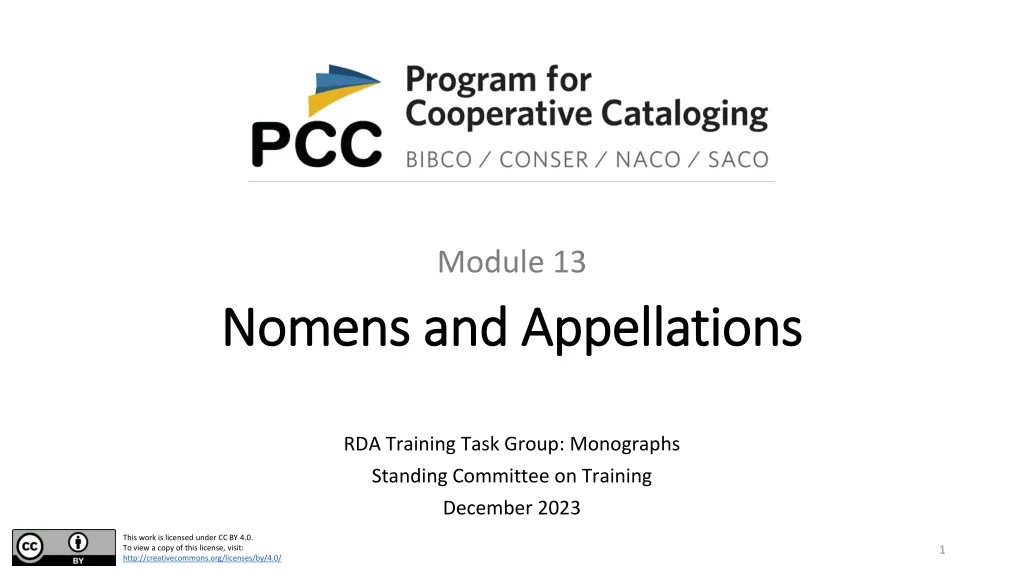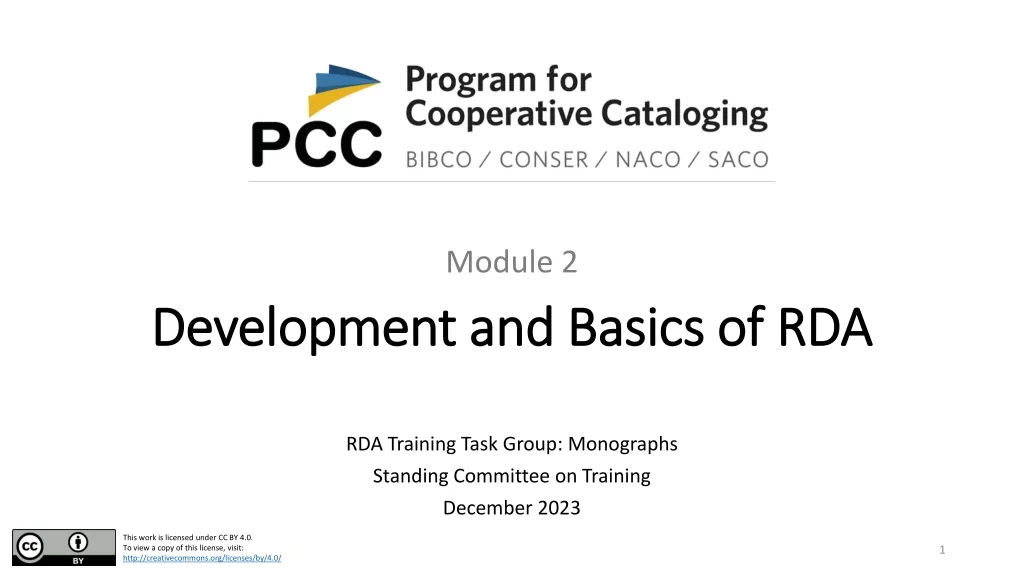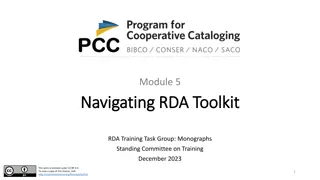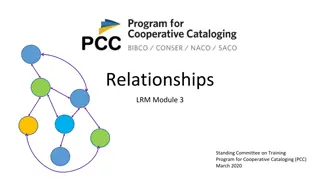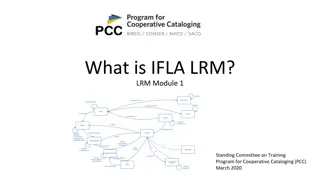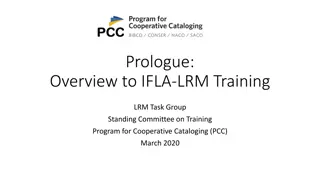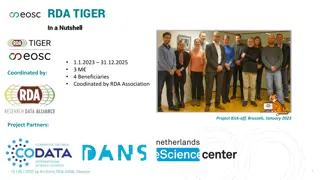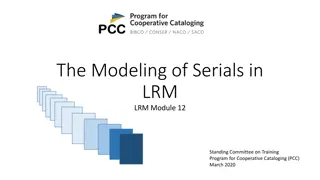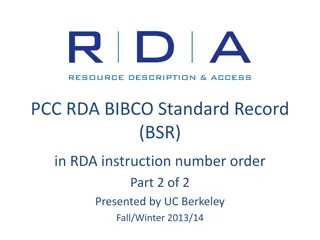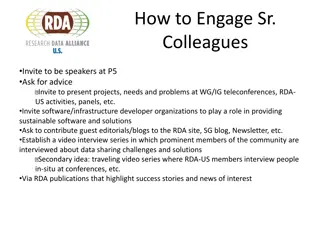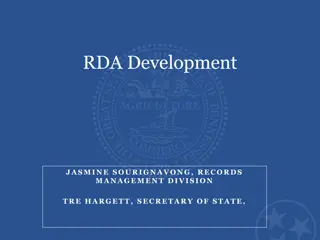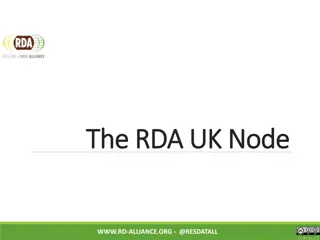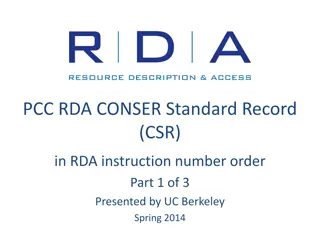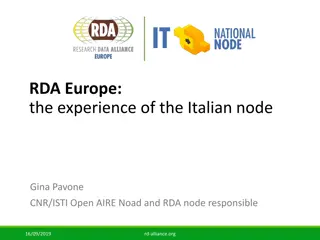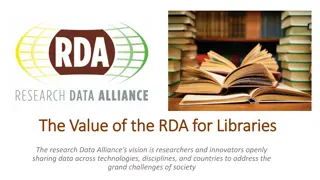Aligning RDA with the LRM
Methodology for aligning RDA with LRM through a 4-fold path focusing on data capture, manifestation statements, transcription, and handling various types of entities like Martians. The presentation covers refinements in RDA entities, related entities, attributes, and identifiers. Exploring the nuances of RDA entities' relationships, nomens, appellation, and the role of identifiers in a global context.
Download Presentation

Please find below an Image/Link to download the presentation.
The content on the website is provided AS IS for your information and personal use only. It may not be sold, licensed, or shared on other websites without obtaining consent from the author.If you encounter any issues during the download, it is possible that the publisher has removed the file from their server.
You are allowed to download the files provided on this website for personal or commercial use, subject to the condition that they are used lawfully. All files are the property of their respective owners.
The content on the website is provided AS IS for your information and personal use only. It may not be sold, licensed, or shared on other websites without obtaining consent from the author.
E N D
Presentation Transcript
Aligning RDA with the LRM Gordon Dunsire Presented to the EURIG seminar, Florence, Italy, 8 May 2017
Overview Methodology for aligning RDA with LRM 4-fold path for data capture and format Nomens Manifestation statements and transcription Examples, and what to do about Martians
Any RDA Thing: Covers all other types of entity FRBR-LRM and RDA entities Res is sub-class of has appellation RDA Entity Nomen is created by W Place E Agent is associated with is sub-class Time-span of M Collective Agent I RDA refines LRM relationships as element sub-types (RDF sub-properties) is modified by P* F C
Refinements is associated with RDA Entity 2 RDA Entity 1 Coarse/General has creator has artist is associated with RDA Entity 1 RDA Entity 3 Fine/Specific is derivative (E) is adapted as (E) is adapted as graphic novel (E)
Nomens and appellations has appellation RDA Entity Nomen has title proper has nomen string My title M1 N1 has title proper has identifier has nomen string 0123-4567 M1 N2 has identifier
4-fold path for related entities [Unstructured description] has nomen string [Structured description] RDA Entity 1 has related entity [Identifier] N1 RDA Entity 2 N2 has appellation
4-fold path for attributes LRM blurs the distinction between attributes and relationships an echo of the 4-fold path A relationship with string data (unstructured or structured description, or identifier) is like an attribute An attribute with "thing" data (IRI), e.g. SKOS concept, is like a relationship
Identifier (path 3) "A nomen consisting of a code, number, or other string, usually independent of natural language and social naming conventions." (Draft) Identifier is distinct from language-based "identifiers" Identifier is "local": not unique at global level Path 4: International Resource Identifier (IRI) or URI is unique at global level
Nomen granularity and hierarchies Current RDA elements form categories of nomens Titles: essentially unstructured descriptions with no "authority"; hierarchical (sub-types) Names: essentially structured labels (descriptions) with "authority"; hierarchical (sub-types) Identifiers; no sub-types No elements for access points: structured descriptions
4-fold path 1: Unstructured 2: Structured 3: Identifier Work to Nomen relationships [has] related nomen (work) [has] represented name of creator (work) [has] subject (nomen) [has] appellation of work [has] identifier for work [has] title of work [has] access point of work 3 [has] preferred title of work [has] variant title of work [AAP] [VAP] 2 1
LRM-E4-A4 Manifestation statements A statement appearing in the manifestation and deemed to be significant for users to understand how the resource represents itself. normally transcribed from a source in a manifestation. Transcription conventions are codified by each implementation. Principle of representation
Basic transcription requirements Support only user task Identify: match source to data Applicable in general to any sequence or layout of the text Independent of languages and scripts, and compatible with transliteration instructions Simple enough for mechanical transcription Basic enough to support local additions and extensions
Transcription in RDA Transcribed data = unstructured description WYSIWYG transcription (machine/clerical) Basic, simple transcription rules Conventional transcription (cataloguer) Current RDA transcription rules Other transcription rules (e.g. ISBD)
Basic transcription rules (draft) Omission: use mark of omission " " White-space: collapse new lines, indentations, and other layout features to a single space Transcribe in order of presentation Delimiters: use double back-slash "\\" to delimit sub-elements (option) De-duplicate contiguous interpolations
Manifestation statement (ms) element (new!) Title and statement of responsibility (ms) Transcribed data . \\ THE IPHIGENEIA AT AULIS OF EURIPIDES \\ EDITED WITH INTRODUCTION AND CRITICAL AND EXPLANATORY NOTES BY E. B. ENGLAND > Title proper (ms) . > Title proper (ms) THE IPHIGENEIA AT AULIS OF EURIPIDES > Statement of responsibility relating to title proper (ms) ENGLAND Publication statement (ms) CO. AND NEW YORK. 1891 EDITED WITH INTRODUCTION AND CRITICAL AND EXPLANATORY NOTES BY E. B. London: MACMILLAN AND
Recorded element Title proper Data 4-fold notes Unstructured SES: Syntax/string encoding scheme VES: Vocabulary Encoding Scheme Title proper The Iphigeneia at Aulis of Euripides Euripidou Iphigeneia en Aulidi Unstructured Variant title Structured: transliteration derived from title proper via transliteration scheme Place of publication London (UK) Structured: preferred label from VES/authority Structured: preferred label from VES/authority Structured: preferred label from VES/authority Structured: year in date-time format from SES Structured: ISBD SES Place of publication New York (USA) Publisher s name Macmillan and Co. Date of publication 1891 Publication statement London ; New York : Macmillan and Co., 1891 Related person England, E. B. Structured nomen from VES: creator of expression responsibility designator
Non-human agents Title and statement of responsibility (ms) > Title proper (ms) THE CHEESE EXPERIMENT > Statement of responsibility relating to title proper (ms) Geronimo Stilton \\ THE CHEESE EXPERIMENT Geronimo Stilton Title proper Represented name of creator (work) The cheese experiment Stilton, Geronimo
Thank you! rscchair@rdatoolkit.org http://access.rdatoolkit.org/ http://www.rdaregistry.info/ http://www.rda-rsc.org/
